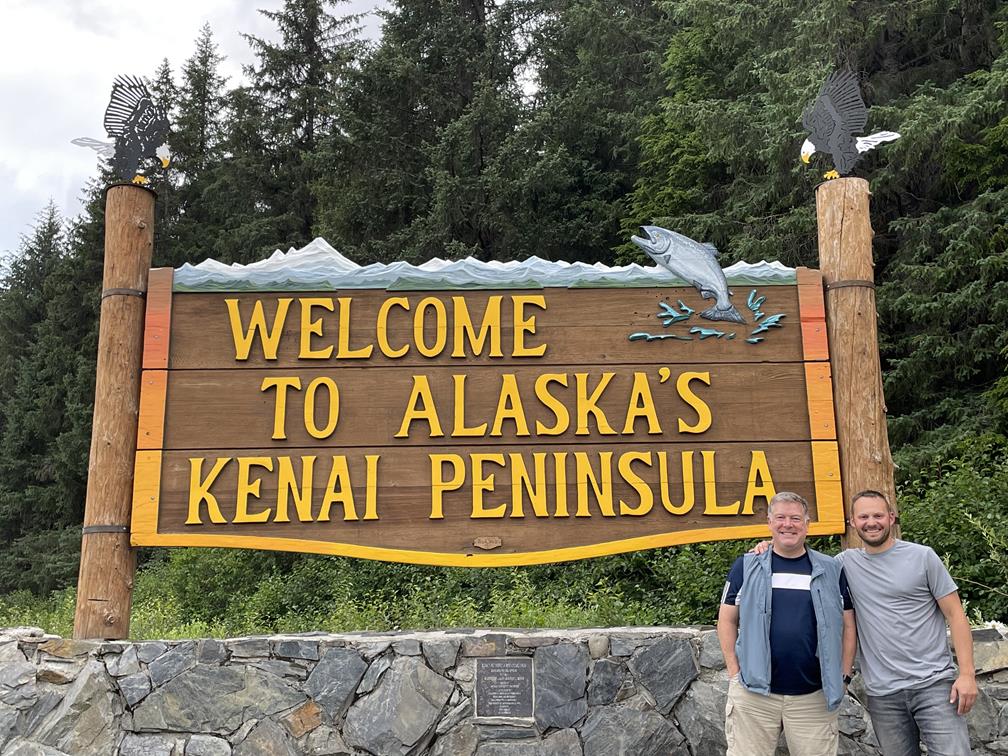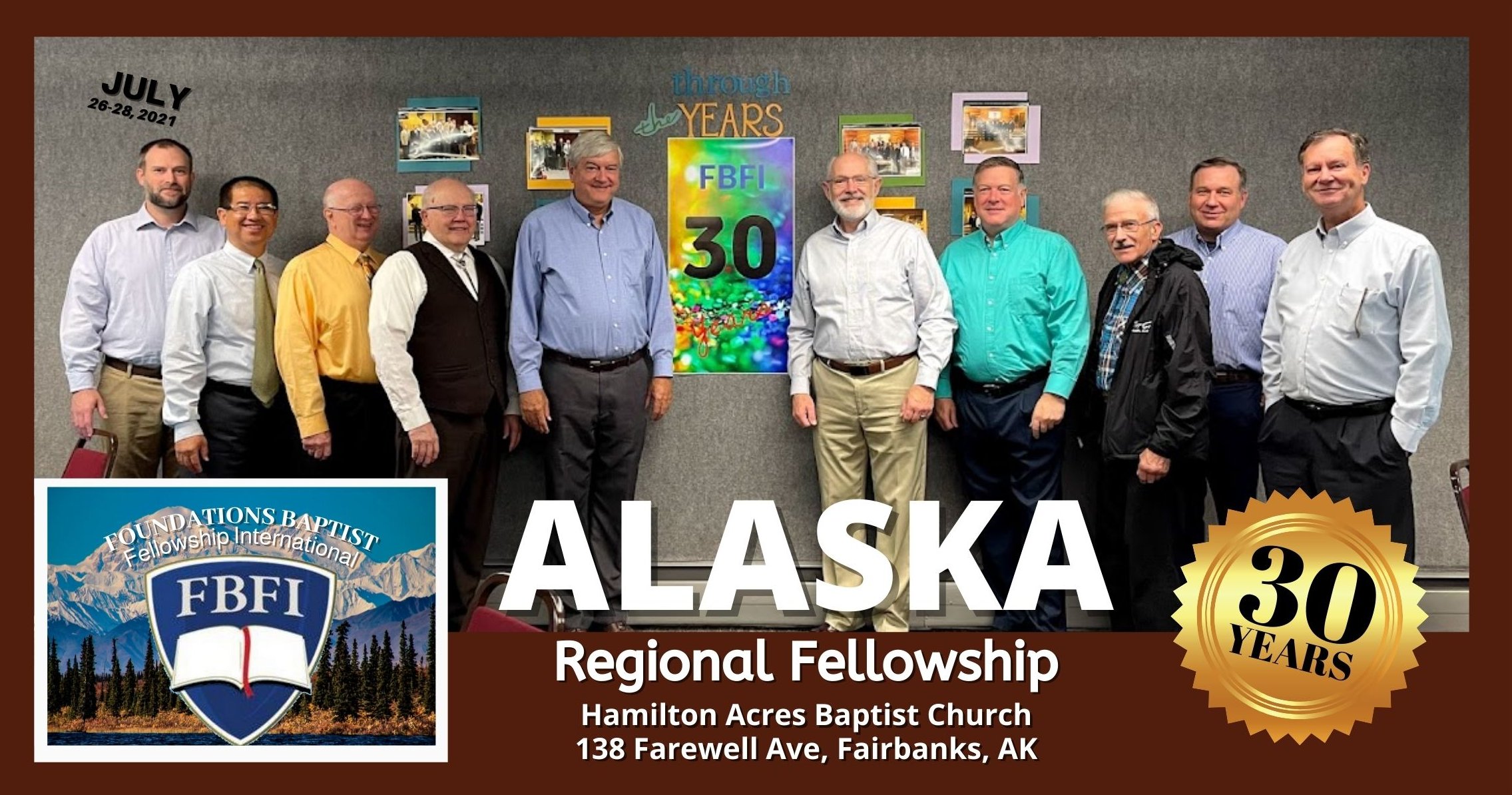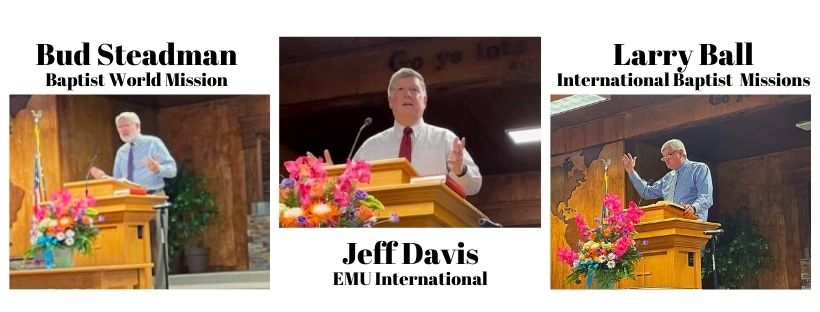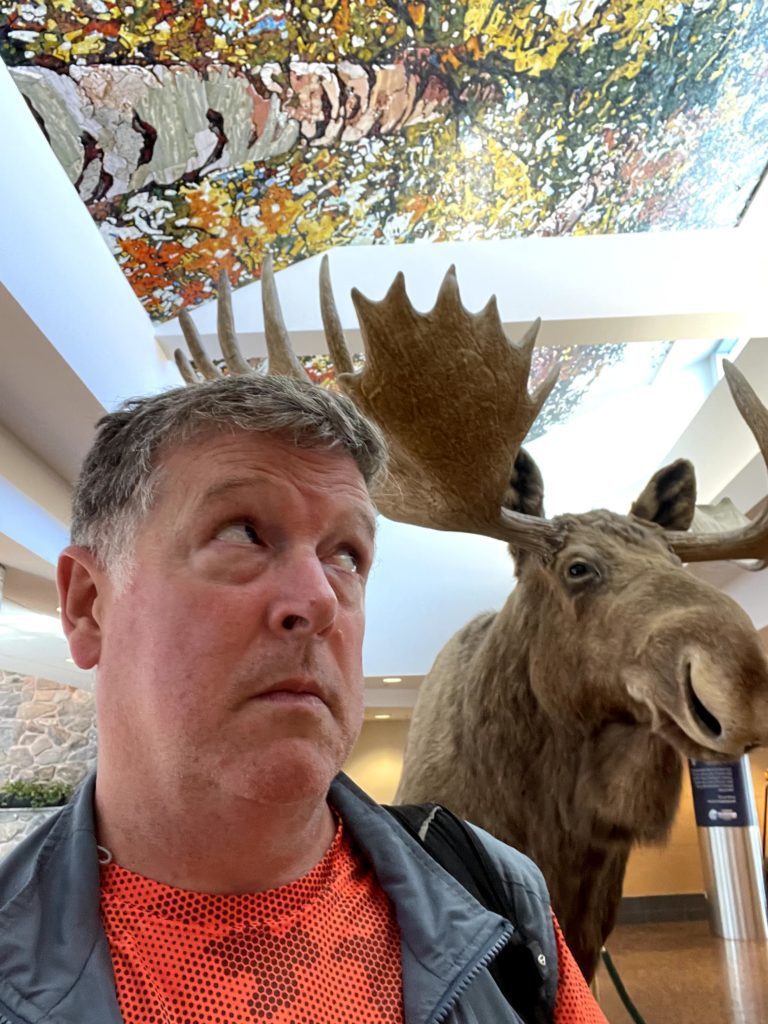On July, 22, I, along with what seemed like half of the population of the lower 48 (a term describing the contiguous states aside from Alaska and Hawaii) arrived at Ted Stevens Anchorage International Airport, named after the late U.S. Senator and World War II pilot. The baggage claim area was full as flights arrived from all over bringing thousands of people to Alaska during the height of salmon running season. Coolers full of fruits and vegetables were brought with hopes of filling them with a bounty of fresh-caught fish upon their return.
Three years ago, I had been invited to participate in a pastors’ conference in Alaska. I jumped at the chance knowing that this would be a great opportunity to connect with a handful of EMU’s supporting churches. I immediately contacted several of them who support our Uruguayan missionaries John Mark and Deborah Steel, with hopes of connecting with the pastors, and Lord willing, scheduling a couple of meetings to share our ministry. Our meetings were scheduled for the Summer of 2020, but due to COVID-19, we had to move everything to 2021.
I had told each of the pastors that I wanted the true Alaska experience. From the moment Pastor Andrew Miller and his wife Kristy picked me up at the airport, I knew I was in for the time of my life. I was overwhelmed by the breathtaking views as we left Anchorage, Alaska’s most populous city, with nearly half of the state’s population living in the greater metropolitan area. Alaska covers an area nearly two and a half times that of Texas. Approximately 736,000 people call Alaska home. Alaska has been called “America’s Last Frontier.” Many people live in remote areas across the vast landscapes in areas that are not reachable by a road system. I began to realize that I was just going to get a small taste of the Alaska experience, a very small taste.
As we left the city, we took Route 1, (there is only one highway) south along the Cook Inlet. We passed several pull-offs where excited tourists were lined up to spot Beluga whales. Everywhere I looked it was a photographer’s paradise, no filter needed. It was like viewing a postcard around every turn. I was told about a bore tide, something that was new to me. This is one of the few places on earth where these walls of 6-10 feet high water can be viewed easily. We followed the highway around Turnagain Arm, making our way to the Kenai Peninsula, known as Alaska’s Playground. The name is well-deserved as just about any outdoor recreation activity you can imagine is available: kayaking, rafting, hiking, glacier viewing, fishing, horseback riding, dog sledding, bear viewing, etc.

It was fun to catch up with Andrew. Twenty-five years earlier, I was the youth pastor, and he was a middle-school child at Grace Baptist Church in Muncie, Indiana. For four years, our families served alongside each other. It was great to hear how God had continued to work in Andrew’s heart and had called him into vocational ministry and locationally called him to Alaska. After a two-and-a-half-hour drive, we arrived in Sterling, a small town where the Kenai and Moose Rivers converge. I was pleasantly surprised when I learned that Pastor Andrew had arranged for me to stay in an R.V., completely furnished, and fully stocked with food. They even had a bowl of banana pudding, my favorite, left for me by Irene Gerrard, the owner of the camper. Andrew provided a truck for me to drive which allowed me to do a little exploring on my own. It was 11 p.m. when I crawled into bed, but it was still a little light outside. Sunset was 11:01 p.m. Alaska is known as the “Land of the Midnight Sun,” and just one month earlier it was light all night long.

Friday morning, Pastor Andrew had arranged for me to go fishing with Scott Peek This gentle giant stands nearly 7 feet tall. His wife is the church secretary. He teaches algebra and shop at a public school. He and one of his neighbors took me out on their boat to fish for salmon on the banks of the Kenai River. Every summer, fishing fanatics from across the world heed the siren call of the spectacular Kenai. It has been said that the Kenai River is to salmon fishing, what the Klondike was to gold. The river supports five species of salmon, with 50-pound Kings not uncommon. The world record 97 pounder was caught in this river. I was there when the Red (Sockeye) Salmon were running. According to the Alaska Department of Fish and Game, there were approximately 35,000 fish in the river that day. What we were doing is known as combat fishing as you stand pretty much shoulder to shoulder with everyone hip-deep in the river. It’s great fun and almost everyone can catch a salmon. Notice, I said, “almost.” We fished for several hours and got our limit, but I couldn’t keep a hook in them. We weren’t trying to get the fish to bite. It is called flossing when you throw out the weighted hook and let it bounce with the current and then jerk the line to snag the fish as he is swimming upstream. I just couldn’t get the feel of it, but as the saying goes, “A bad day on the water is better than a good day at the office.” Even though I toiled all night and took nothing, I could get hooked on fishing like this.

On Saturday late morning, Pastor Andrew and I enjoyed a great time of fellowship and discussion over a delicious brunch. One of the joys that I have of traveling and sitting down with pastors is listening to their story and learning about their vision for ministry. Having pastored for twenty-five years, I often find myself shepherding shepherds as I listen, and pray with these amazing servants. Ministry in Alaska is not without its challenges. Like any other mission field, the people of Alaska have deep spiritual needs. Every region of the state is affected by drugs, homelessness, poverty, and alcoholism. During the long Winters, the sun barely rises above the horizon. The many hours of darkness take a great toll on Alaskans. Seasonal Affective Disorder (S.A.D.), also known as Cabin Fever, is very real.
Sunday morning, I had the privilege of preaching and presenting the ministry of EMU International at Sterling Baptist Church. The people were very kind and receptive to the message. Pastor Andrew and his wife Kristy moved to the Kenai Peninsula in the spring of 2016. In the short time that he has served as pastor, it is evident that he has intentionally inserted himself into the community, deliberately looking to build redemptive relationships. On Sunday evening, we had “Church in the Park.” There was no preaching, just life-on-life, as we sought to connect with the people in the Sterling and Soldotna community.

Monday morning, Andrew, along with three of his boys, drove me back to Anchorage to the airport. As we made our way up Route 1, I was struck by the beauty of the Kenai Lake. I had to stop and take a few photos of the majestic view of this glacial lake and its turquoise water, caused by light reflecting off silt suspended in its water.
I was scheduled to speak later that evening in Fairbanks. It would have been a ten-hour drive, so the two-and-a-half-hour drive, followed by a $100, one-way flight, was well worth it. Alaska is a state that is dependent on aviation. Therefore, it is not surprising that Alaskans have built one of the nicer airports in the country in Anchorage International. The in-air flight time is only forty-one minutes, and once we were above the clouds, I enjoyed a spectacular view of Denali, the highest mountain peak in North America, with a summit elevation of 20,310 feet above sea level.

Our plane landed in Fairbanks, the heart of the interior of Alaska, also known as the Gateway to the Arctic. I was greeted by Pastor Bruce Hamilton. His church, Hamilton Acres Baptist Church, also supports the Steels. They were the host church for the Foundations Baptist Fellowship Alaska Regional Conference where I would preach over the next three days. It was great to get to know Pastor Bruce and hear his story.
Since 1968, when he was 9 years old, his family has lived in Alaska. His ministry trek took him to Bible college in Tennessee, followed by a time as youth director and Christian school teacher. Following that, he and his wife Lena traveled in itinerant ministry throughout Alaska and the contiguous states, Canada, and Russia, preaching evangelistic meetings, youth camps, and sportsman’s banquets. Their ministry of teaching and preaching the Word of God became more stationary once the church installed Bruce as senior pastor. He is a true outdoorsman and has chronicled many of his stories in a couple of fictional books, “God of the Brooks,” and “God of the Gold,” that highlight God’s providence in the rough and rugged rawness of the Alaska wilderness. They are real page-turners and I highly recommend them.

As we made our way to my host family’s house, he told me about a third book that he is writing that will be a part of his “God of Alaska” series. The book is titled, “God of the Aurora: The Holy Spirit’s Call to the Asian People.” It chronicles the truly miraculous story of God’s work in Fairbanks among the Asian community which began with a seat assignment change on a flight from Seattle to Fairbanks. The first chapter of the book is called, “The Story of Row 6.” God had providentially changed Bruce’s seat and he ended up sitting next to a couple of Chinese girls. As they talked, he showed them photos of Fairbanks, of Alaska wildlife, and of his wife, Lena. One of them said that she was very beautiful and that she would love to meet her. He invited the girls to their Easter service that weekend. They were blown away by the celebration. This chance encounter began a relationship that has now grown to a seven-day-a-week one-on-one ministry. They now have monthly gatherings in homes for worship. As God continues to open doors for ministry, a church plant seems to be in the future. Many of the Chinese people visit Fairbanks to see the majestic Aurora Borealis, the colorful lights that dance unpredictably through the Arctic night during Fall and Winter. He told me that Asian people of all kinds are drawn to the Aurora. For many, it is the number one thing on their bucket list. Some of the tour guides have come to know the Lord. They share Bibles and talk about the God of the Aurora. They are now working with over one hundred Asian people. In addition, Bruce has made several trips to Mainland China where he works with 150-200 people directly connected through the Holy Spirit’s work in Alaska. For the past five years, they have been introduced to a new person every three weeks, all as a ripple effect of Row 6.
My gracious hosts for the next three nights were John and Tammy Rowe. They provided me a nice vehicle which allowed me to explore a little bit of Fairbanks on my own. They are leaders at Hamilton Acres Baptist Church. Tammy helped with the delicious meals that we enjoyed during the conference. The meeting began on Monday evening with a meal followed by two services. Thirty years earlier the FBFI held its first organizational meeting at this same church. At the time, Bruce’s father, Hugh Hamilton served as pastor. He had attended a national meeting in Denver and wanted to bring that same spirit of ministerial camaraderie to Alaska. Pastor Earl Barnett and Pastor Lyn Wyckoff were a part of this organizational meeting. Joining me in the conference as speakers were Bud Steadman, director of Baptist World Mission, and Larry Ball, director of International Baptist Missions. Not only, were we challenged by good preaching, but the organic times of fellowship provided wonderful opportunities to strengthen one another. On Wednesday evening, I expressed to the pastors that I could definitely see the draw to Alaska. Of course, I was saying that in July. I haven’t experienced Fairbanks in January where the median temperature last year was -7 degrees.
On a clear Thursday morning, Pastor Jon Craven and his wife Becky met me at the church where we loaded up their van for a ten-hour drive back to the Kenai Peninsula. My wife Joanna and I worked with Becky at the Wilds Christian Camp, thirty-two years earlier. She later worked on staff at the Wilds of the Rockies where she and Jon met. Several years ago, Becky’s brother Paul taught for us at our Christian School in Wilson, NC. After a quick stop for fuel, the caffeinated kind, and a breakfast bagel, we hit Route 3 South headed towards Denali National Park. Alaska is home to eight National Parks, with 2.7 million visitors per year. Four of them are only accessible by bush plane. You know, like the ones that are always crashing in the movies. Denali is six million acres of lakes, tundra, peaks, and wildlife. As we approached the park, the weather became very cloudy. Jon said that the temperamental mountain creates its own weather. Only 30% of the time can you actually see the mountain from the overlooks. We stopped after four hours at Viewpoint South, but it was too cloudy to see the mountain. I had come to understand how dependent Alaska is on aviation. If you wanted to truly see Alaska and go where the roads can’t take you, several places offered flightseeing tours.
As we drove, Jon told me his story and how the Lord led his family to Soldotna Baptist Church, a church that was started by Paul and Esther Weimer, missionaries with Baptist Mid-Missions, in 1958. Jon was called to be the Youth Pastor in 1996. He later would become the director of Higher Ground Baptist Bible Camp in Sterling. Pastor Andrew, who I was with one week earlier, lives at the entrance to the camp. In May of 2016, the church called Jon to be the Senior Pastor.
After about an hour’s drive, we stopped for fuel and lunch in the small town of Talkeetna, an eccentric community of artists, musicians, mountain climbers, and bush pilots. We then drove through Wasilla, near Palmer, and made our way to the Turnagain Pass. in the Winter it is known as a ski and snowmachine mecca. In the summer, it is bright with wildflowers, particularly Fireweed, the ubiquitous magenta flower that covers the Alaskan landscape. I was surprised to learn that it is not the state flower. That honor goes to the bright blue Alpine Forget-me-not. Fireweed blooms from the bottom to the top, sometimes growing as tall as eight feet. In early Fall, it has terminal spike-like clusters of red blossoms. It is said that when the fiery red bloom reaches the top, it’s only six weeks until winter.
After a brief stop in Girdwood, we followed Route 1 back to Soldotna, and then Jon and Becky’s home in Kenai. We met up with Becky’s brother Tim, an evangelist who was with his family in Alaska for several weeks. They had supper ready for us. Jon then took me to my host family’s home. What a joy it was to get to know Jeremiah and Jennifer Cates and their sons Ethan and Evan. Jeremiah is a former Army Chaplain and a leader in the church.
We had a men’s prayer meeting on Saturday morning. Jeremiah and I then visited the Higher Ground Baptist Camp where his son Evan and the Craven boys had just returned from a weeklong Canoe Camp led by the camp director Eric Locker. The boys had enjoyed a week of camping and fishing as they canoed down a river north of Anchorage. Later that afternoon, Jeremiah took me and his two sons fishing back on the Kenai. I hooked several fish, but could not get them in. He on the other hand did very well. As a side note, I just saw a video on Facebook of his son Evan, catching a 155-pound halibut this past weekend.

Sunday was a great day as I had the opportunity to preach at Soldotna Baptist Church, another congregation that supports the Steels. We then enjoyed a delicious potluck lunch, followed by a Communion Service. I then shared the ministry of EMU International. After a brief rest that afternoon, the Cravens along with their children, Becky’s brother, and his family, and I drove an hour-and-a-half to the coastal town of Homer. Driving South, small towns dotted the coastline along the way: Nikiski, Kasilof, Clam Gulch, Ninilchik, and Anchor Point. Each one with its own personality and story to tell. Some of the buildings date back to over 100 years.
Homer is home to the Alaska Maritime National Wildlife Refuge, the largest wildlife refuge in Alaska. We made our way to the Homer Spit, a 4.5-mile finger of land that juts into Kachemak Bay. The road is lined with campsites, shops, and restaurants. We stopped at a hotel at the end appropriately named Land’s End. Walking on the beach, we watched the ferry arrive and even got to see a sea otter splashing in the 50-degree waters. There is a slogan describing Homer which says, “The end of the road, the beginning of the adventure.” Maybe the Lord will allow me to return one day to deep-sea fish for halibut or take a water taxi across the Bay to the small town of Seldovia.

We enjoyed a picnic in a nearby park and then stopped for S’mores at a friend’s beach house which overlooked the Cook Inlet with views of four active volcanoes. As we drove home that evening, we saw a moose on the side of the road. When we arrived back at the Cates house around 11 p.m., at twilight, we spotted a mama moose and two calves in the backyard.
Monday morning, I packed my bags, said goodbye to my new friends, and drove with Jon and Becky for one more morning of exploring before heading to Anchorage for my return flight. Jon wanted me to visit Seward. On our way, we took a turn down an eight-mile road, that led us to the Exit Glacier. After a brief stop at the overlook, we made our way to the parking lot, and then hiked a thirty-minute climb up an easy mountain trail to the rocky overlook of the Exit Glacier. If we had more time, we could have continued hiking and viewed the 700 square mile Harding Ice Field.

While driving into Seward, we passed Mount Marathon. Pastor Jon told me about how every Fourth of July, the town of 4,000 would grow to 25,000, and runners would race in what is called “the toughest 5K on the planet,” to see who would be the first to summit the mountain. It is the second-oldest footrace in the USA. Seward is a scenic coastal town sandwiched between Resurrection Bay and the Kenai Mountains. It is one of the oldest towns in Alaska. It is known as the “Gateway to the Kenai Fjords,” known for its plentiful wildlife and dramatic scenery. Over the centuries, powerful glacial carvings have created several emerald-green, deep inlets called fjords. This picturesque coastal community is known for its historic shopping district and its harbor with fresh seafood arriving at its docks several times a day. Pastor Jon and Becky wanted me to experience a meal of fish and chips. I enjoyed a delicious basket of halibut and cod, as we sat outside and overlooked Resurrection Bay.

One thing that impressed me about Alaska is that it is so large, but at the same time, it seems small, because everyone is so friendly and seems to know everyone else. I had told each of the pastors that I wanted the true Alaska experience. I had come to realize that it can’t be done in twelve days
Robert Service, in his poem, “The Spell of the Yukon,” expresses my sentiments about Alaska, “There’s a land—oh, it beckons and beckons, and I want to go back—and I will.” John Mark Steel left me a voice message saying that he would help me move the EMU office to Alaska. It probably won’t happen, but I could see the draw for Alaska, at least in July.


